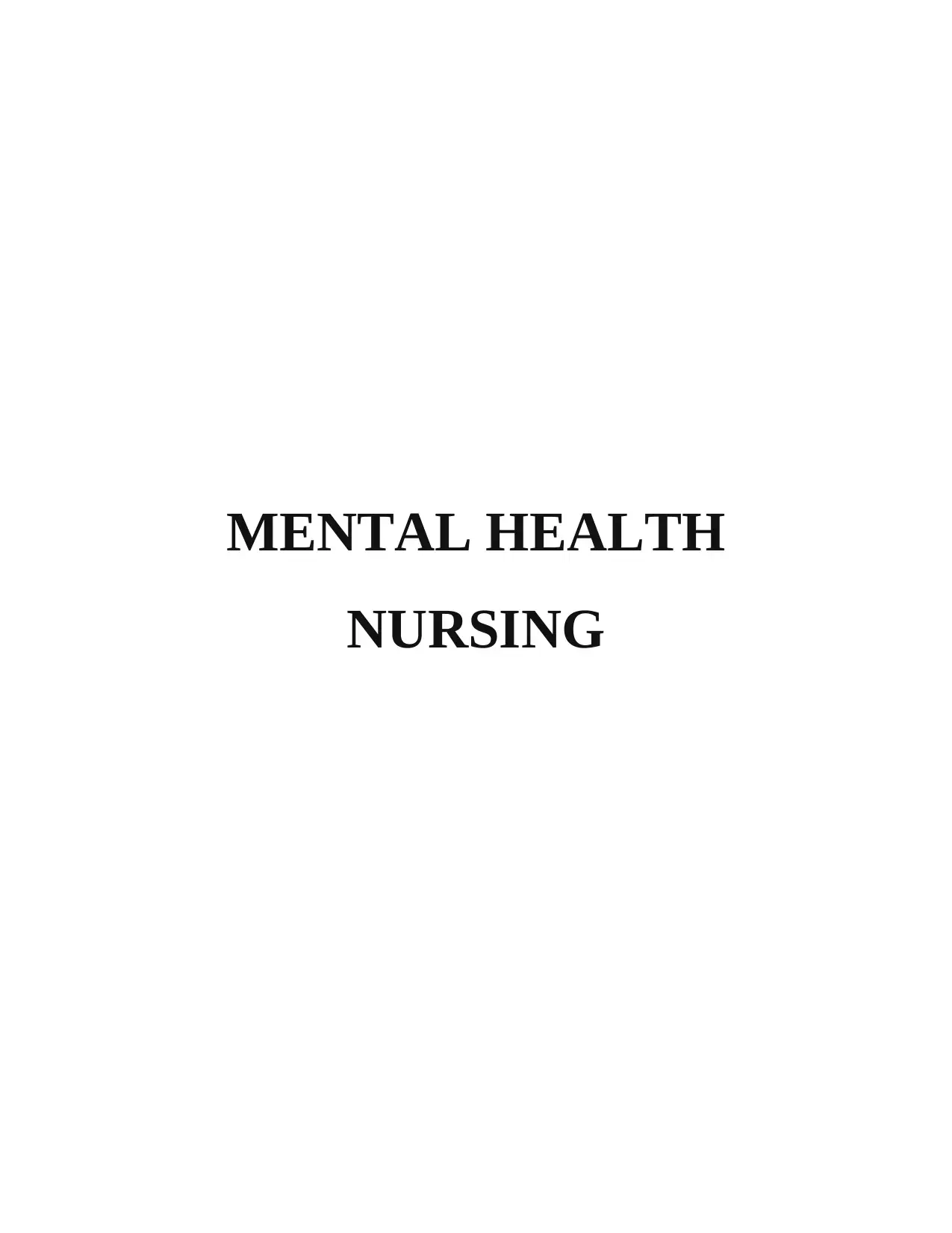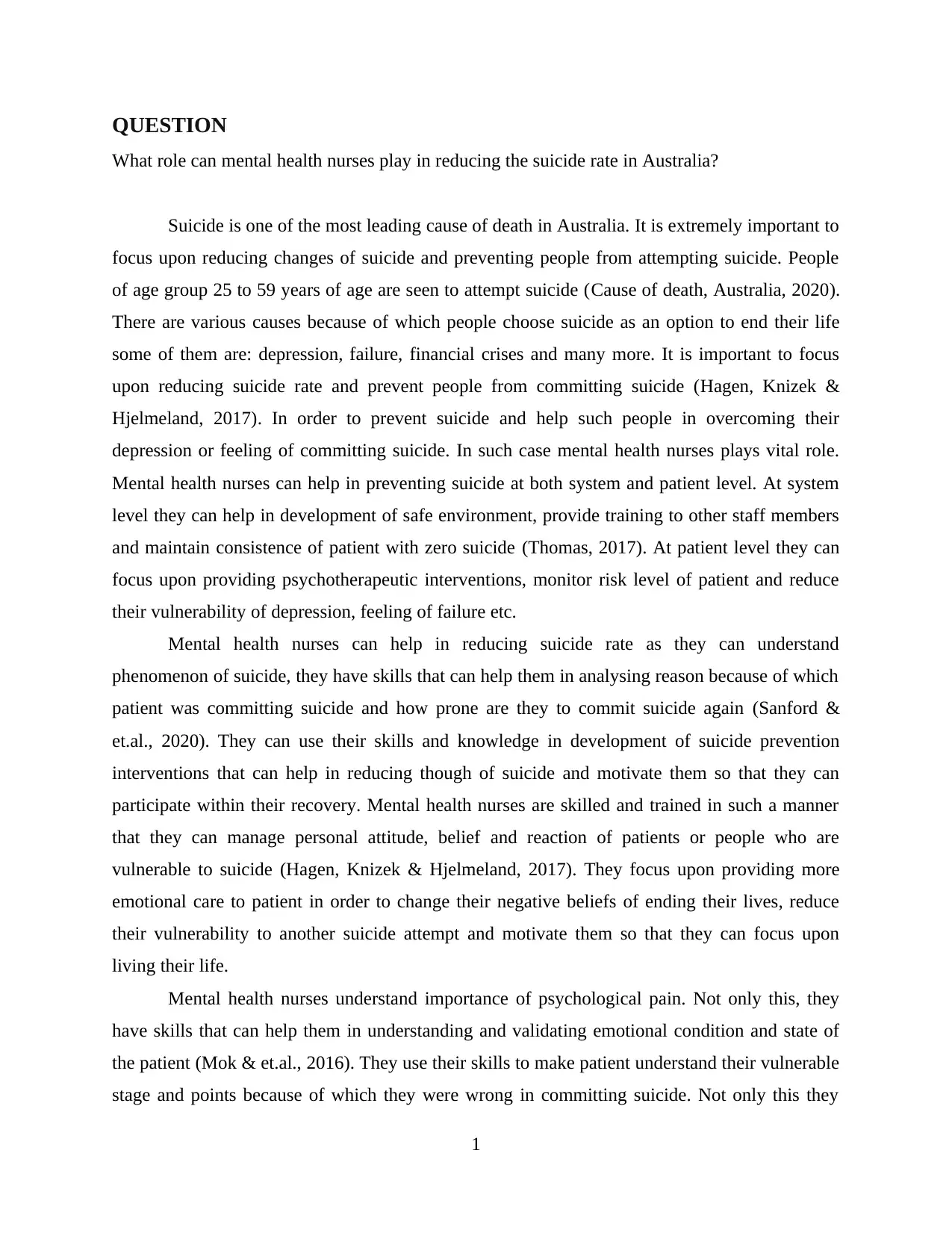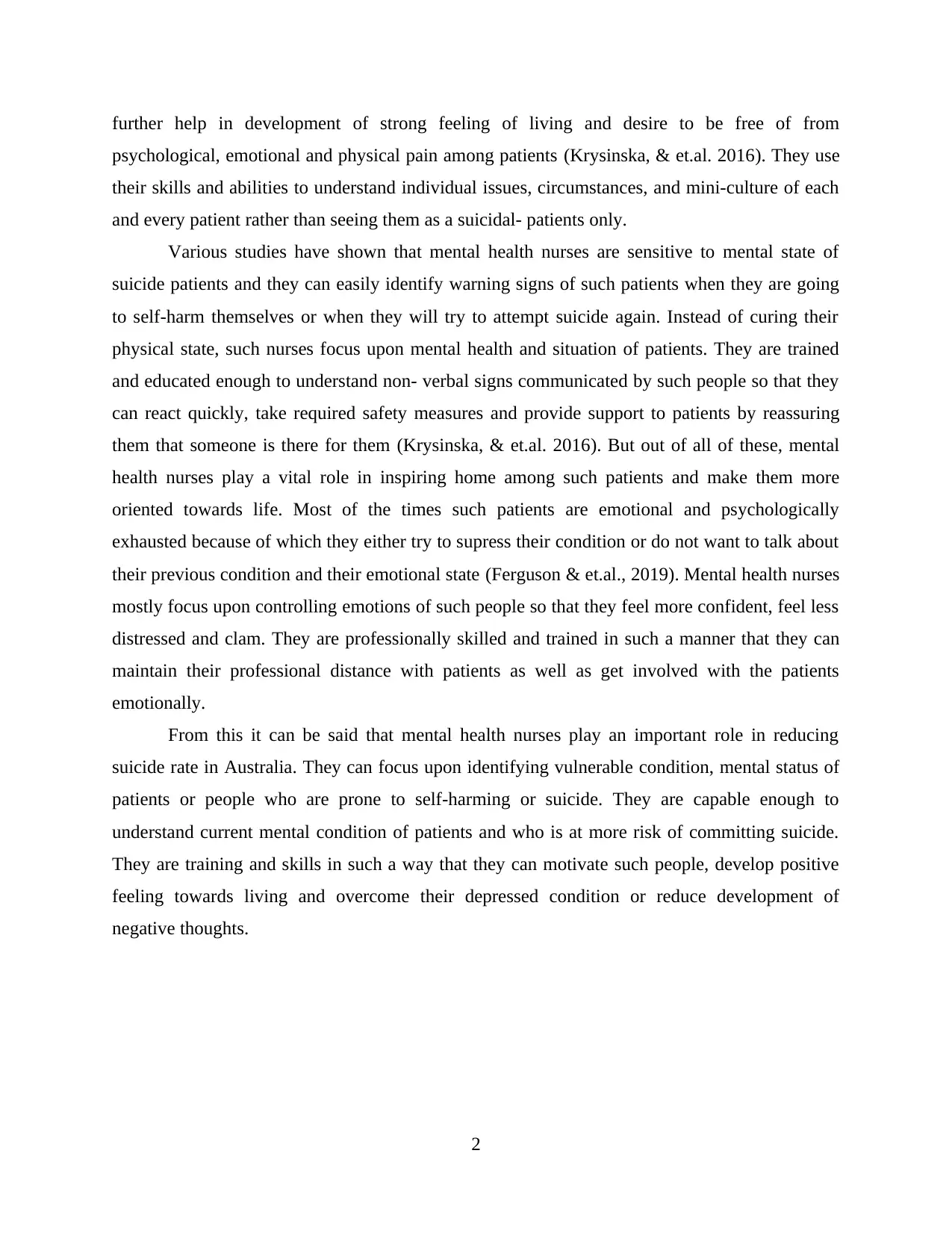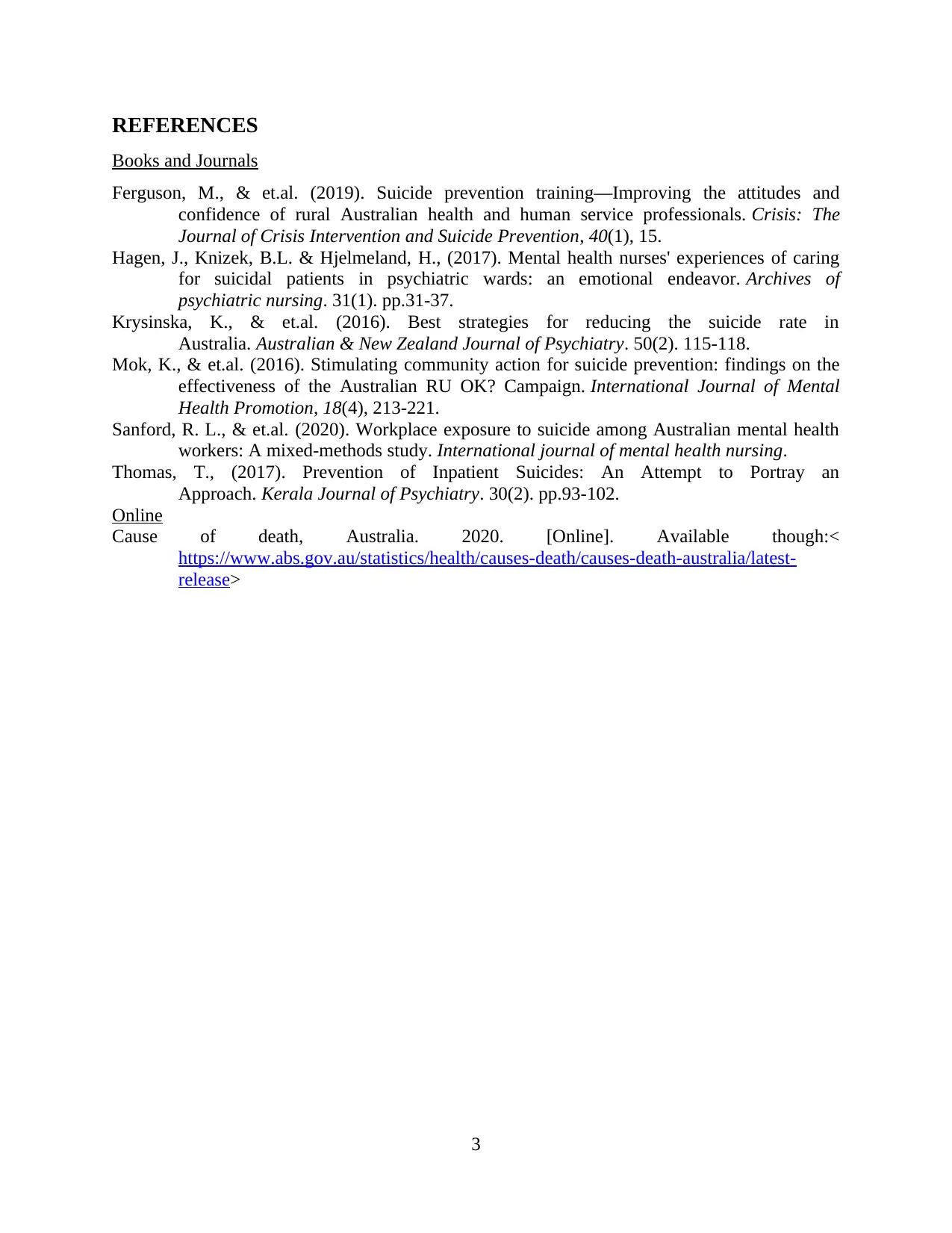Mental Health Nursing's Role in Reducing Suicide in Australia
VerifiedAdded on 2023/01/06
|4
|1126
|27
Essay
AI Summary
This essay explores the significant role mental health nurses play in reducing the suicide rate in Australia, a leading cause of death. It highlights their interventions at both the system and patient levels, including developing safe environments, providing staff training, psychotherapeutic interventions, and monitoring patient risk. The essay emphasizes the nurses' skills in understanding the phenomenon of suicide, analyzing patient motivations, and developing prevention strategies. Mental health nurses are trained to manage patient emotions, validate their emotional states, and foster a desire for life. They address individual patient circumstances, recognize warning signs, and provide emotional support. By inspiring hope and providing care, mental health nurses are instrumental in supporting patients and reducing suicide rates. The essay references several studies and journals to support its claims.

MENTAL HEALTH
NURSING
NURSING
Paraphrase This Document
Need a fresh take? Get an instant paraphrase of this document with our AI Paraphraser

QUESTION
What role can mental health nurses play in reducing the suicide rate in Australia?
Suicide is one of the most leading cause of death in Australia. It is extremely important to
focus upon reducing changes of suicide and preventing people from attempting suicide. People
of age group 25 to 59 years of age are seen to attempt suicide (Cause of death, Australia, 2020).
There are various causes because of which people choose suicide as an option to end their life
some of them are: depression, failure, financial crises and many more. It is important to focus
upon reducing suicide rate and prevent people from committing suicide (Hagen, Knizek &
Hjelmeland, 2017). In order to prevent suicide and help such people in overcoming their
depression or feeling of committing suicide. In such case mental health nurses plays vital role.
Mental health nurses can help in preventing suicide at both system and patient level. At system
level they can help in development of safe environment, provide training to other staff members
and maintain consistence of patient with zero suicide (Thomas, 2017). At patient level they can
focus upon providing psychotherapeutic interventions, monitor risk level of patient and reduce
their vulnerability of depression, feeling of failure etc.
Mental health nurses can help in reducing suicide rate as they can understand
phenomenon of suicide, they have skills that can help them in analysing reason because of which
patient was committing suicide and how prone are they to commit suicide again (Sanford &
et.al., 2020). They can use their skills and knowledge in development of suicide prevention
interventions that can help in reducing though of suicide and motivate them so that they can
participate within their recovery. Mental health nurses are skilled and trained in such a manner
that they can manage personal attitude, belief and reaction of patients or people who are
vulnerable to suicide (Hagen, Knizek & Hjelmeland, 2017). They focus upon providing more
emotional care to patient in order to change their negative beliefs of ending their lives, reduce
their vulnerability to another suicide attempt and motivate them so that they can focus upon
living their life.
Mental health nurses understand importance of psychological pain. Not only this, they
have skills that can help them in understanding and validating emotional condition and state of
the patient (Mok & et.al., 2016). They use their skills to make patient understand their vulnerable
stage and points because of which they were wrong in committing suicide. Not only this they
1
What role can mental health nurses play in reducing the suicide rate in Australia?
Suicide is one of the most leading cause of death in Australia. It is extremely important to
focus upon reducing changes of suicide and preventing people from attempting suicide. People
of age group 25 to 59 years of age are seen to attempt suicide (Cause of death, Australia, 2020).
There are various causes because of which people choose suicide as an option to end their life
some of them are: depression, failure, financial crises and many more. It is important to focus
upon reducing suicide rate and prevent people from committing suicide (Hagen, Knizek &
Hjelmeland, 2017). In order to prevent suicide and help such people in overcoming their
depression or feeling of committing suicide. In such case mental health nurses plays vital role.
Mental health nurses can help in preventing suicide at both system and patient level. At system
level they can help in development of safe environment, provide training to other staff members
and maintain consistence of patient with zero suicide (Thomas, 2017). At patient level they can
focus upon providing psychotherapeutic interventions, monitor risk level of patient and reduce
their vulnerability of depression, feeling of failure etc.
Mental health nurses can help in reducing suicide rate as they can understand
phenomenon of suicide, they have skills that can help them in analysing reason because of which
patient was committing suicide and how prone are they to commit suicide again (Sanford &
et.al., 2020). They can use their skills and knowledge in development of suicide prevention
interventions that can help in reducing though of suicide and motivate them so that they can
participate within their recovery. Mental health nurses are skilled and trained in such a manner
that they can manage personal attitude, belief and reaction of patients or people who are
vulnerable to suicide (Hagen, Knizek & Hjelmeland, 2017). They focus upon providing more
emotional care to patient in order to change their negative beliefs of ending their lives, reduce
their vulnerability to another suicide attempt and motivate them so that they can focus upon
living their life.
Mental health nurses understand importance of psychological pain. Not only this, they
have skills that can help them in understanding and validating emotional condition and state of
the patient (Mok & et.al., 2016). They use their skills to make patient understand their vulnerable
stage and points because of which they were wrong in committing suicide. Not only this they
1

further help in development of strong feeling of living and desire to be free of from
psychological, emotional and physical pain among patients (Krysinska, & et.al. 2016). They use
their skills and abilities to understand individual issues, circumstances, and mini-culture of each
and every patient rather than seeing them as a suicidal- patients only.
Various studies have shown that mental health nurses are sensitive to mental state of
suicide patients and they can easily identify warning signs of such patients when they are going
to self-harm themselves or when they will try to attempt suicide again. Instead of curing their
physical state, such nurses focus upon mental health and situation of patients. They are trained
and educated enough to understand non- verbal signs communicated by such people so that they
can react quickly, take required safety measures and provide support to patients by reassuring
them that someone is there for them (Krysinska, & et.al. 2016). But out of all of these, mental
health nurses play a vital role in inspiring home among such patients and make them more
oriented towards life. Most of the times such patients are emotional and psychologically
exhausted because of which they either try to supress their condition or do not want to talk about
their previous condition and their emotional state (Ferguson & et.al., 2019). Mental health nurses
mostly focus upon controlling emotions of such people so that they feel more confident, feel less
distressed and clam. They are professionally skilled and trained in such a manner that they can
maintain their professional distance with patients as well as get involved with the patients
emotionally.
From this it can be said that mental health nurses play an important role in reducing
suicide rate in Australia. They can focus upon identifying vulnerable condition, mental status of
patients or people who are prone to self-harming or suicide. They are capable enough to
understand current mental condition of patients and who is at more risk of committing suicide.
They are training and skills in such a way that they can motivate such people, develop positive
feeling towards living and overcome their depressed condition or reduce development of
negative thoughts.
2
psychological, emotional and physical pain among patients (Krysinska, & et.al. 2016). They use
their skills and abilities to understand individual issues, circumstances, and mini-culture of each
and every patient rather than seeing them as a suicidal- patients only.
Various studies have shown that mental health nurses are sensitive to mental state of
suicide patients and they can easily identify warning signs of such patients when they are going
to self-harm themselves or when they will try to attempt suicide again. Instead of curing their
physical state, such nurses focus upon mental health and situation of patients. They are trained
and educated enough to understand non- verbal signs communicated by such people so that they
can react quickly, take required safety measures and provide support to patients by reassuring
them that someone is there for them (Krysinska, & et.al. 2016). But out of all of these, mental
health nurses play a vital role in inspiring home among such patients and make them more
oriented towards life. Most of the times such patients are emotional and psychologically
exhausted because of which they either try to supress their condition or do not want to talk about
their previous condition and their emotional state (Ferguson & et.al., 2019). Mental health nurses
mostly focus upon controlling emotions of such people so that they feel more confident, feel less
distressed and clam. They are professionally skilled and trained in such a manner that they can
maintain their professional distance with patients as well as get involved with the patients
emotionally.
From this it can be said that mental health nurses play an important role in reducing
suicide rate in Australia. They can focus upon identifying vulnerable condition, mental status of
patients or people who are prone to self-harming or suicide. They are capable enough to
understand current mental condition of patients and who is at more risk of committing suicide.
They are training and skills in such a way that they can motivate such people, develop positive
feeling towards living and overcome their depressed condition or reduce development of
negative thoughts.
2
⊘ This is a preview!⊘
Do you want full access?
Subscribe today to unlock all pages.

Trusted by 1+ million students worldwide

REFERENCES
Books and Journals
Ferguson, M., & et.al. (2019). Suicide prevention training—Improving the attitudes and
confidence of rural Australian health and human service professionals. Crisis: The
Journal of Crisis Intervention and Suicide Prevention, 40(1), 15.
Hagen, J., Knizek, B.L. & Hjelmeland, H., (2017). Mental health nurses' experiences of caring
for suicidal patients in psychiatric wards: an emotional endeavor. Archives of
psychiatric nursing. 31(1). pp.31-37.
Krysinska, K., & et.al. (2016). Best strategies for reducing the suicide rate in
Australia. Australian & New Zealand Journal of Psychiatry. 50(2). 115-118.
Mok, K., & et.al. (2016). Stimulating community action for suicide prevention: findings on the
effectiveness of the Australian RU OK? Campaign. International Journal of Mental
Health Promotion, 18(4), 213-221.
Sanford, R. L., & et.al. (2020). Workplace exposure to suicide among Australian mental health
workers: A mixed‐methods study. International journal of mental health nursing.
Thomas, T., (2017). Prevention of Inpatient Suicides: An Attempt to Portray an
Approach. Kerala Journal of Psychiatry. 30(2). pp.93-102.
Online
Cause of death, Australia. 2020. [Online]. Available though:<
https://www.abs.gov.au/statistics/health/causes-death/causes-death-australia/latest-
release>
3
Books and Journals
Ferguson, M., & et.al. (2019). Suicide prevention training—Improving the attitudes and
confidence of rural Australian health and human service professionals. Crisis: The
Journal of Crisis Intervention and Suicide Prevention, 40(1), 15.
Hagen, J., Knizek, B.L. & Hjelmeland, H., (2017). Mental health nurses' experiences of caring
for suicidal patients in psychiatric wards: an emotional endeavor. Archives of
psychiatric nursing. 31(1). pp.31-37.
Krysinska, K., & et.al. (2016). Best strategies for reducing the suicide rate in
Australia. Australian & New Zealand Journal of Psychiatry. 50(2). 115-118.
Mok, K., & et.al. (2016). Stimulating community action for suicide prevention: findings on the
effectiveness of the Australian RU OK? Campaign. International Journal of Mental
Health Promotion, 18(4), 213-221.
Sanford, R. L., & et.al. (2020). Workplace exposure to suicide among Australian mental health
workers: A mixed‐methods study. International journal of mental health nursing.
Thomas, T., (2017). Prevention of Inpatient Suicides: An Attempt to Portray an
Approach. Kerala Journal of Psychiatry. 30(2). pp.93-102.
Online
Cause of death, Australia. 2020. [Online]. Available though:<
https://www.abs.gov.au/statistics/health/causes-death/causes-death-australia/latest-
release>
3
1 out of 4
Related Documents
Your All-in-One AI-Powered Toolkit for Academic Success.
+13062052269
info@desklib.com
Available 24*7 on WhatsApp / Email
![[object Object]](/_next/static/media/star-bottom.7253800d.svg)
Unlock your academic potential
Copyright © 2020–2025 A2Z Services. All Rights Reserved. Developed and managed by ZUCOL.





